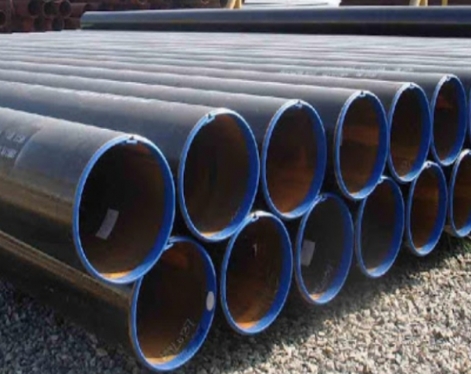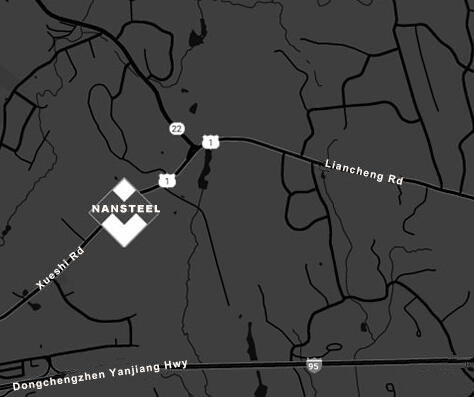What is Carbon Steel erw Pipe?
Carbon steel erw pipe, that is, electric resistance welded carbon steel pipe, is called Electric Resistance Welding Carbon Steel Pipe in English. "ERW" is the abbreviation of the English name of Electric Resistance Welding. It is a carbon steel pipe made by resistance welding process and is a more common type in the carbon steel pipe family.
During manufacturing, carbon steel ERW pipes are made of hot-rolled or cold-rolled carbon steel strips. The strips are first fed into a forming unit, and then gradually bent and deformed through a series of rollers to form a round tube blank. Subsequently, the edges of the tube blank are heated to a molten state by high-frequency current, and under the pressure of the extrusion rollers, the edges of the tube blank are fused to each other to form a strong weld, thus completing the transformation from steel strip to ERW tube.
What are the characteristics of carbon steel erw pipe?
1. The weld quality is high, no welding materials are added during the welding process, and the weld metal undergoes a recrystallization process and has the same chemical composition as the base material. If annealing is performed after welding, both the cold working internal stress and the welding internal stress can be improved, and the comprehensive mechanical properties are better.
2. High precision is also a highlight of carbon steel erw pipes. The pipe diameter tolerance can be controlled within ±0.5%, and the ovality tolerance is within ±0.3%, which can meet application scenarios with high requirements for dimensional accuracy.
3. Fast production speed is also an advantage of carbon steel erw pipes that cannot be ignored. It adopts continuous assembly line operation, and its production efficiency is 30% - 50% higher than some traditional pipe making processes, which greatly reduces production costs and can quickly respond to large market demands.

Advantages and Disadvantages of Carbon Steel erw Pipe
Advantages
1. The biggest advantage of carbon steel erw pipe is its low cost. Because it is produced in a continuous assembly line, the production efficiency is 30% - 50% higher than some traditional pipe making processes, which greatly reduces the production cost.
2. Its application range is also extremely wide, ranging from supporting components in building structures, to oil and natural gas pipelines, to parts processing in mechanical manufacturing and other fields.
3. In addition, the processing of carbon steel erw pipes is also very convenient. Because of its uniform steel structure, cutting, bending, welding and other processing operations can be easily completed, and it can quickly adapt to the diverse needs of different projects.
Disadvantages
1. Its corrosion resistance is relatively poor. It is prone to rust and corrosion in highly corrosive environments such as moisture, acid and alkali, which greatly limits its use in special environments.
2. In terms of pressure resistance, carbon steel erw pipes are also limited and are generally suitable for medium and low pressure environments. When the pressure is too high, the pipe may be deformed or even ruptured, and cannot meet the needs of special working conditions such as high pressure and high temperature.
3. Its bending radius is large. For some complex pipeline laying scenarios that require a smaller bending radius, the use of carbon steel erw pipes is not suitable, which will affect the construction progress and quality of the project. In addition, its welding performance is average, and appropriate welding processes and techniques need to be adopted during the welding process, otherwise welding defects are likely to occur, affecting the overall performance of the pipe.
How to choose the right carbon steel erw pipe?
1. Material selection: Select appropriate carbon steel material based on the use environment and working conditions. In normal temperature and pressure environment, ordinary Q235 carbon steel material can meet the needs.
2. Performance requirements: fully consider the mechanical properties, corrosion resistance, wear resistance, etc. of the steel pipe. For example, when used for oil and natural gas transportation, steel pipes are required to have high strength and good corrosion resistance.
3. Specification matching: Accurately select the appropriate pipe diameter and wall thickness according to design requirements. The selection of pipe diameter should be determined according to the flow rate and flow velocity of the fluid to ensure smooth fluid transportation; The wall thickness should be calculated based on the working pressure, temperature and material of the pipe to ensure that the pipe will not deform or rupture under working conditions.
4. Cost-effectiveness: On the premise of meeting performance requirements, compare the prices of carbon steel erw pipes from different manufacturers and brands, and select reasonably priced products to maximize cost-effectiveness. However, we should not only focus on the price but also ignore the quality. Low-quality pipes may cause problems in the project, and the cost of subsequent repairs and replacements may be higher.
Read more: The difference between ERW Pipe, DOM Pipe and Seamless Pipe
Carbon steel erw pipe, that is, electric resistance welded carbon steel pipe, is called Electric Resistance Welding Carbon Steel Pipe in English. "ERW" is the abbreviation of the English name of Electric Resistance Welding. It is a carbon steel pipe made by resistance welding process and is a more common type in the carbon steel pipe family.
During manufacturing, carbon steel ERW pipes are made of hot-rolled or cold-rolled carbon steel strips. The strips are first fed into a forming unit, and then gradually bent and deformed through a series of rollers to form a round tube blank. Subsequently, the edges of the tube blank are heated to a molten state by high-frequency current, and under the pressure of the extrusion rollers, the edges of the tube blank are fused to each other to form a strong weld, thus completing the transformation from steel strip to ERW tube.
What are the characteristics of carbon steel erw pipe?
1. The weld quality is high, no welding materials are added during the welding process, and the weld metal undergoes a recrystallization process and has the same chemical composition as the base material. If annealing is performed after welding, both the cold working internal stress and the welding internal stress can be improved, and the comprehensive mechanical properties are better.
2. High precision is also a highlight of carbon steel erw pipes. The pipe diameter tolerance can be controlled within ±0.5%, and the ovality tolerance is within ±0.3%, which can meet application scenarios with high requirements for dimensional accuracy.
3. Fast production speed is also an advantage of carbon steel erw pipes that cannot be ignored. It adopts continuous assembly line operation, and its production efficiency is 30% - 50% higher than some traditional pipe making processes, which greatly reduces production costs and can quickly respond to large market demands.

Advantages and Disadvantages of Carbon Steel erw Pipe
Advantages
1. The biggest advantage of carbon steel erw pipe is its low cost. Because it is produced in a continuous assembly line, the production efficiency is 30% - 50% higher than some traditional pipe making processes, which greatly reduces the production cost.
2. Its application range is also extremely wide, ranging from supporting components in building structures, to oil and natural gas pipelines, to parts processing in mechanical manufacturing and other fields.
3. In addition, the processing of carbon steel erw pipes is also very convenient. Because of its uniform steel structure, cutting, bending, welding and other processing operations can be easily completed, and it can quickly adapt to the diverse needs of different projects.
Disadvantages
1. Its corrosion resistance is relatively poor. It is prone to rust and corrosion in highly corrosive environments such as moisture, acid and alkali, which greatly limits its use in special environments.
2. In terms of pressure resistance, carbon steel erw pipes are also limited and are generally suitable for medium and low pressure environments. When the pressure is too high, the pipe may be deformed or even ruptured, and cannot meet the needs of special working conditions such as high pressure and high temperature.
3. Its bending radius is large. For some complex pipeline laying scenarios that require a smaller bending radius, the use of carbon steel erw pipes is not suitable, which will affect the construction progress and quality of the project. In addition, its welding performance is average, and appropriate welding processes and techniques need to be adopted during the welding process, otherwise welding defects are likely to occur, affecting the overall performance of the pipe.
How to choose the right carbon steel erw pipe?
1. Material selection: Select appropriate carbon steel material based on the use environment and working conditions. In normal temperature and pressure environment, ordinary Q235 carbon steel material can meet the needs.
2. Performance requirements: fully consider the mechanical properties, corrosion resistance, wear resistance, etc. of the steel pipe. For example, when used for oil and natural gas transportation, steel pipes are required to have high strength and good corrosion resistance.
3. Specification matching: Accurately select the appropriate pipe diameter and wall thickness according to design requirements. The selection of pipe diameter should be determined according to the flow rate and flow velocity of the fluid to ensure smooth fluid transportation; The wall thickness should be calculated based on the working pressure, temperature and material of the pipe to ensure that the pipe will not deform or rupture under working conditions.
4. Cost-effectiveness: On the premise of meeting performance requirements, compare the prices of carbon steel erw pipes from different manufacturers and brands, and select reasonably priced products to maximize cost-effectiveness. However, we should not only focus on the price but also ignore the quality. Low-quality pipes may cause problems in the project, and the cost of subsequent repairs and replacements may be higher.
Read more: The difference between ERW Pipe, DOM Pipe and Seamless Pipe









